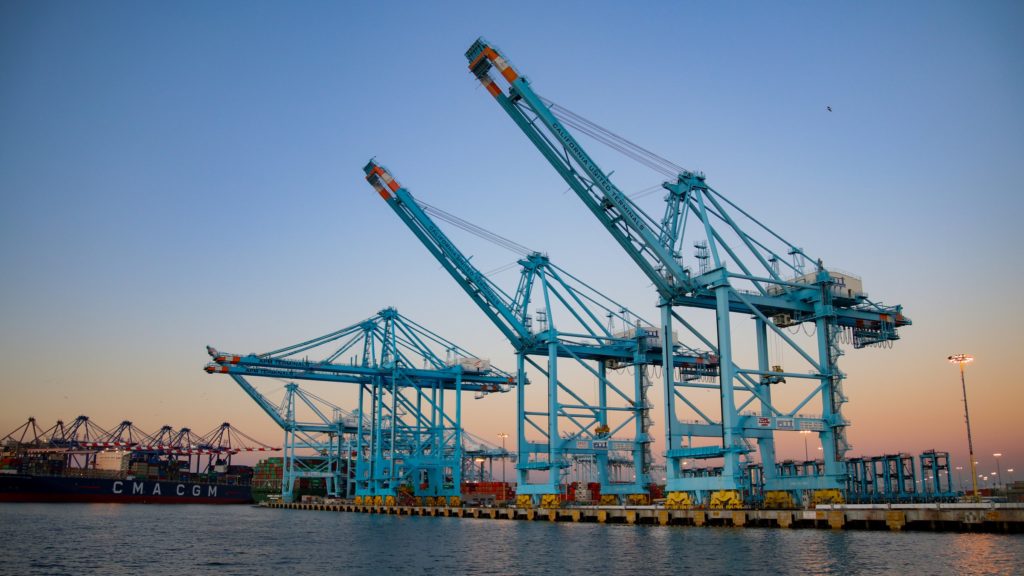Written by Staff Attorney Lauren Chase
While cruising down PCH, walking along the beach, surfing, bird or marine mammal watching in Southern California recently, have you found yourself counting the ships dotting the horizon? 1… 2… 3… 4… 20… 40… 60… 100?!
Indeed, the nation’s largest ports – the ports of Los Angeles and Long Beach, respectively – are experiencing record-breaking bottlenecks due to a perfect storm of supply chain disruptions, crushing consumer demands, and increased ship sizes with more containers to unload than ever before. Over the last few months, there have been a series of unprecedented numbers of cargo ships anchored or drifting offshore waiting for a berth at the ports. Despite White House attention, both ports moving towards 24/7 operations, and heftier fines for idling containers, the backlog is expected to last through the holiday season. Starting November 16, arriving ships will have to wait farther offshore in an effort to improve safety and air quality, but pushing the problem farther out of sight does not address the root cause.
Clogged ports, more extreme weather events, and larger ships with ever-growing container stacks create increased risks for marine environments.
You may have heard about the ongoing investigation into a cargo ship’s anchor as the suspected cause of the recent Huntington Beach oil spill, but there is another shipping industry issue you may not be aware of: containers going overboard.
According to the World Shipping Council, an average of 1,382 containers were lost at sea each year from 2008-2019, and given the lack of mandatory reporting requirements, many take these figures as a conservative estimate. Last year, amidst COVID-19 restrictions and online shopping crazes, this figure spiked with an estimated 3,000 containers lost at sea from November 2020 to early January 2021. In one incident alone, the ONE Apus lost a reported 1,816 containers in heavy weather while traveling from China to Long Beach. 54 of the lost containers had “dangerous goods,” including fireworks, batteries, and liquid ethanol.

In January 2021, the Maersk Essen lost a self-reported, approximate 750 containers in severe weather en route from Xiamen, China, to Los Angeles. The following month, a different Maersk ship, the Eindhoven, lost a self-reported 260 containers during the same crossing. Already this season, a cargo ship carrying hazardous materials caught fire and lost approximately 109 containers near British Columbia in late October 2021. To date, only four of the containers have washed ashore. Why does this happen and what does all of this mean for our oceans?
Containers fall overboard for a variety of reasons ranging from incorrect container loading and securing to increasingly extreme, climate change-induced storm events. While the impacts of sunken containers on marine environments have not been widely studied, a research team of scientists from the Monterey Bay National Marine Sanctuary (MBNMS) and the Monterey Bay Aquarium Research Institute (MBARI) assessed the impacts of a submerged container discovered within the MBNMS. The team found that the container altered local flow patterns and benthic community make-up with a disturbance zone around 20 times its footprint. Estimating the container will remain on the seafloor for hundreds of years, the researchers expressed concerns that the continuous build-up of sunken containers throughout the ocean could act as “stepping stones” for invasive species. The team also expressed concerns about the potential, longer-term impacts of container toxicity on marine life.
So what can we do about this? At an industry level, and with your support, we can advocate for more standardized and effective restrictions on stack height, weight distribution, and lashing. These policy measures, when paired with robust enforcement regimes, can help prevent container losses.
Additionally, we can pressure industry and government to impose …
- Mandatory container loss reporting and recovery requirements; and
- More robust enforcement regimes for instances of container loss, including automatic, mandatory minimum penalties to fund restoration efforts.
Meanwhile, at the individual level, we can all use the power of our pocketbooks. With every purchase, you make and within the resources available to you, opt to shop used, local, and sustainable. If you truly need new things shipped to you, select the slowest available speed to minimize haste.
This holiday season, Coastkeeper challenges our members to opt-out of traditional consumer gifting and opt-in for a slightly different approach.
Rather than buying “stuff” for loved ones on your holiday list, consider…
- Planning an experience you can share together, such as a hike, beach picnic, surf lesson, or scuba diving course;
- Creating a DIY gift, with bonus points for using upcycled materials;
- Baking and gifting your favorite holiday treat; or
- Donating to Orange County Coastkeeper or another organization near and dear to your loved ones’ heart for a gift that keeps on giving.





